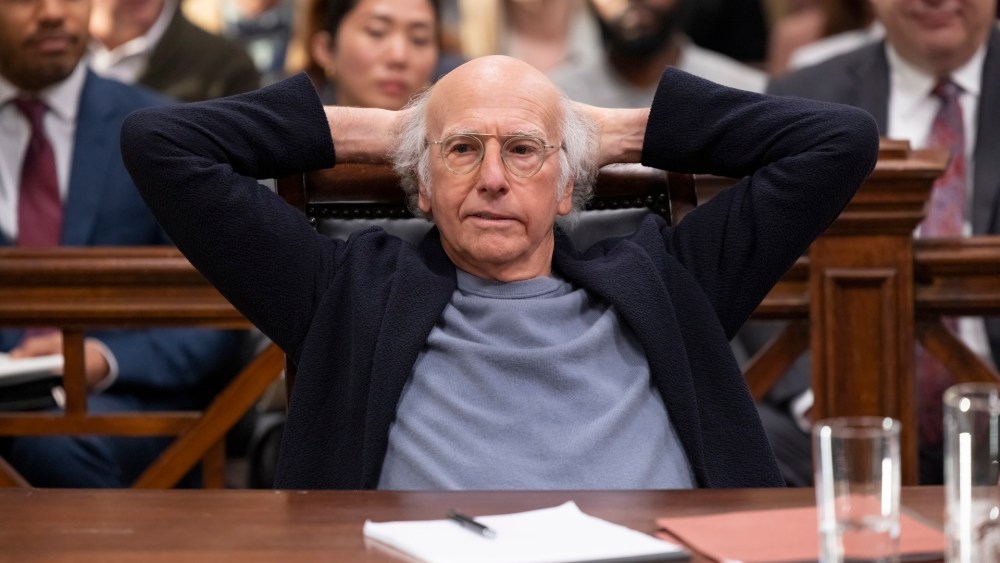SPOILER ALERT: This text discusses plot factors from the sequence finale of “Curb Your Enthusiasm.”
Larry David acquired the chance to revise the controversial ending he’d chosen for his first extensively beloved TV sequence, and he stayed fairly near the formulation. However whereas his earlier sequence ended with its protagonist in jail, his present one is ending with David himself strolling free.
This season of “Curb Your Enthusiasm” had appeared, from its first episode, to be constructing towards an ending that both mirrored or inverted the way in which “Seinfeld,” co-created by David and Jerry Seinfeld, had wrapped up in 1998. The season’s mega-arc has been the continued uncertainty across the character Larry’s having by accident run afoul of Georgia election legal guidelines. And, all through the season, askance references to the “Seinfeld” finale (which featured the core forged going to jail after having been compelled to listen to infinite testimony as to their self-centeredness) instructed that the correct solution to wrap up a sequence was very a lot on David’s thoughts.
The “Seinfeld” finale — which David, who had left the sequence, returned to write down — was pilloried on the time, but when one watches it immediately, outdoors the warmth of the present’s press-choreographed march to the end line, it’s not unhealthy. It’s only a bit sloppy. In that, it was already extra like a generic episode of “Curb” than a generic episode of “Seinfeld” — after which the “Curb” finale simply reiterated the formulation. I’ll admit that I used to be shocked to comprehend that this “Curb” episode, within the current day, actually was simply doing the trial formulation yet again, and that I used to be dismayed that the character witnesses, this time, have been plucked typically although not completely from latest episodes. (“Seinfeld’s” witnesses, just like the Soup Nazi, had the burden of getting blossomed by fashionable mandate into TV historical past; “Curb’s” included Bruce Springsteen, speaking about one thing that occurred on final week’s episode; Alexander Vindman was additionally again, for some cause.)
“Seinfeld” ended with its characters confined to jail, put away on a technicality after years of abusing their fellow man. It’s prime Larry David, in that it looks as if an ending David had in thoughts, towards which he constructed a sequence of occasions that made sense — kind of. “Curb’s” ending was nonetheless extra complicated: Larry is convicted, however then let off on a technicality after the real-life Jerry Seinfeld sees a juror breaking sequester, spurring a mistrial ruling. Larry flies off into the sundown, with a comparatively uninspired quarrel with Susie (Susie Essman) marking the tip of this narrative. Earlier within the episode, David had made the barely-buried subtext of the sequence textual content: Confronting a toddler, he appears prepared to inform him off or to ship unsolicited parenting recommendation to his mom, earlier than declaring, “I’m 76 years previous, and I’ve by no means realized a lesson in my total life.”
Jail can’t wake him up, however TV manufacturing may: One can learn this episode because the response to classes he realized from the response to the “Seinfeld” finale. And there are, certainly, moments of enjoyable that have been lacking there — David and Seinfeld, strolling out of jail collectively, comment how far more enjoyable it will have been if Jerry, Elaine and the gang had gotten an analogous last-minute reprieve. Ha-ha. And Essman has nice moments elsewhere within the finale, earlier than her look within the out-of-ideas ultimate scene.
However the finale spoke, in the principle, to each the strengths and weaknesses of “Curb” relative to what may — had he been much less formidable within the years after — have been David’s nice work. “Seinfeld” was elastic for a community present, but it surely had its limits. “Curb,” which debuted as an everyday sequence in 2000 after first airing as a particular in 1999, is as previous as this century, and has moved ahead by perpetually pushing limits. It’s carried out a stable if not all the time optimally elegant job of monitoring the evolving dinner-party trending subjects over 20 years. The present’s on-the-fly nature — with its wholly improvised conversations constructed across the free define of a plot — successfully invented a class of leisure, but in addition implies that the present is by its nature a blunt instrument. Larry and his mates are loopily, outrageously humorous; they dwell out loud; they play video games of one-upsmanship which are genuinely pleasant to observe. However they’re not often sly.
This, as a lot because the West Coast-vs.-East Coast divide or the profanity allowed by premium cable, is what differentiates “Curb” from “Seinfeld” — on the latter sequence, (practically) each episode’s ultimate minutes had a satisfying, Swiss-watch high quality, because the disparate storylines clicked neatly into place and the characters got here again collectively as soon as extra. “Curb” has made a observe of bringing its episodes in for memorable landings, too, however its endings extra continuously come as wild, who’d-have-thunk narrative swings. (This has turn into more true and more true in latest seasons, the development of which has grown ever extra lackadaisical.) On “Seinfeld,” one admires the logic; on “Curb,” one admires the audacity.
Which additionally meant that on “Seinfeld,” those that weren’t bitterly disillusioned by the finale might respect a sure poetic logic to it. The one poetry to “Curb’s” finale was free verse. (It’s telling that on “Seinfeld’s” finale, we noticed all of the witnesses and acquired their tales positioned in context; towards the tip of “Curb’s” testimony towards Larry, a prosecutor performed by Greg Kinnear was simply itemizing off issues that had occurred on a sequence that was improvisatory to the tip.) Larry will probably be missed. However he could deserve a break.
